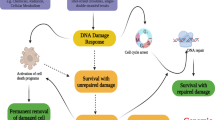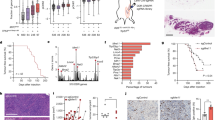Abstract
DNA damage response (DDR), the guardian of genomic integrity, emerges as an oncogene-inducible biological barrier against progression of cancer beyond its early stages. Recent evidence from both cell culture and animal models as well as analyses of clinical specimens show that activation of numerous oncogenes and loss of some tumour suppressors result in DNA replication stress and DNA damage that alarm the cellular DDR machinery, a multifaceted response orchestrated by the ATR–Chk1 and ATM–Chk2 kinase signalling pathways. Such activation of the DDR network leads to cellular senescence or death of oncogene-transformed cells, resulting in delay or prevention of tumorigenesis. At the same time, the ongoing chronic DDR activation creates selective pressure that eventually favours outgrowth of malignant clones with genetic or epigenetic defects in the genome maintenance machinery, such as aberrations in the ATM–Chk2–p53 cascade and other DDR components. Furthermore, the executive DDR machinery is shared by at least two anticancer barriers, as both the oncogene-induced DNA replication stress and telomere shortening impact the cell fate decisions through convergence on DNA damage signalling. In this study, we highlight recent advances in this rapidly evolving area of cancer research, with particular emphasis on mechanistic insights, emerging issues of special conceptual significance and discussion of major remaining challenges and implications of the concept of DDR as a tumorigenesis barrier for experimental and clinical oncology.
This is a preview of subscription content, access via your institution
Access options
Subscribe to this journal
Receive 50 print issues and online access
$259.00 per year
only $5.18 per issue
Buy this article
- Purchase on Springer Link
- Instant access to full article PDF
Prices may be subject to local taxes which are calculated during checkout

Similar content being viewed by others
References
Bartek J, Lukas J . (2007). DNA damage checkpoints: from initiation to recovery or adaptation. Curr Opin Cell Biol 19: 238–245.
Bartkova J, Bakkenist CJ, Rajpert-De Meyts E, Skakkebæk NE, Sehested M, Lukas J et al. (2005b). ATM activation in normal human tissues and testicular cancer. Cell Cycle 4: 838–845.
Bartkova J, Horejsi Z, Koed K, Kramer A, Tort F, Zieger K et al. (2005a). DNA damage response as a candidate anti-cancer barrier in early human tumorigenesis. Nature 434: 864–870.
Bartkova J, Horejsi Z, Sehested M, Nesland JM, Rajpert-De Meyts E, Skakkebæk NE et al. (2007a). DNA damage response mediators MDC1 and 53BP1: Constitutive activation and aberrant loss in breast and lung cancer, but not in testicular germ cell tumours. Oncogene; e-pub ahead of print: 4 June 2007.
Bartkova J, Rajpert-De Meyts E, Skakkebæk NE, Lukas J Bartek J . (2007b). DNA damage response in human testes and testicular germ cell tumors: biology and implications for therapy. J Androl 30: 282–291.
Bartkova J, Rezaei N, Liontos M, Karakaidos P, Kletsas D, Issaeva N et al. (2006). Oncogene-induced senescence is part of the tumorigenesis barrier imposed by DNA damage checkpoints. Nature 444: 633–637.
Branzei D, Foiani M . (2005). The DNA damage response during DNA replication. Curr Opin Cell Biol 17: 568–575.
Bryant HE, Schultz N, Thomas HD, Parker KM, Flowed D, Lopez E et al. (2005). Specific killing of BRCA2-deficient tumours with inhibitors of poly(ADP-ribose) polymerase. Nature 434: 913–917.
Campisi J, d’Adda di Fagagna F . (2007). Cellular senescence: when bad things happen to good cells. Nat Rev Cancer 8: 729–740.
d’Adda di Fagagna F, Reaper PM, Clay-Farrace L, Fiegler H, Carr P, von Zglinicki T et al. (2003). A DNA damage checkpoint response in telomere-initiated senescence. Nature 426: 194–198.
d’Adda di Fagagna F, Teo SH, Jackson SP . (2004). Functional links between telomeres and proteins of the DNA-damage response. Genes Dev 18: 1781–1799.
Di Micco R, Fumagalli M, Cicalese A, Piccini S, Gasparini P, Luise C et al. (2006). Oncogene-induced senescence is a DNA damage response triggered by DNA hyper-replication. Nature 444: 638–642.
DiTullio RA, Mochan TA, Venere M, Bartkova J, Sehested M, Bartek J et al. (2002). 53BP1 functions in an ATM-dependent checkpoint pathway that is constitutively activated in human cancer. Nat Cell Biol 4: 998–1002.
Fan C, Quan R, Feng X, Gillis A, He L, Matsumoto ED et al. (2006). ATM activation is accompanied with earlier stages of prostate tumorigenesis. Biochim Biophys Acta 1763: 1090–1097.
Farmer H, McCabe N, Lord CJ, Tutt AN, Johnson DA, Richardson TB et al. (2005). Targeting the DNA repair defect in BRCA mutant cells as a therapeutic strategy. Nature 434: 917–921.
Finkel T, Serrano M, Blasco MA . (2007). The common biology of cancer and ageing. Nature 448: 767–774.
Frame FM, Rogoff HA, Pickering MT, Cress WD, Kowalik TF . (2006). E2F1 induces MRN foci formation and a cell cycle checkpoint response in human fibroblasts. Oncogene 25: 3258–6326.
Gorgoulis VG, Vassiliou LV, Karakaidos P, Zacharatos P, Kotsinas A, Liloglou T et al. (2005). Activation of the DNA damage checkpoint and genomic instability in human precancerous lesions. Nature 434: 907–913.
Hoeijmakers JH . (2001). Genome maintenance mechanisms for preventing cancer. Nature 411: 366–374.
Kastan M, Bartek J . (2004). Cell-cycle checkpoints and cancer. Nature 432: 316–323.
Lukas J, Lukas C, Bartek J . (2004). Mammalian cell cycle checkpoints: signalling pathways and their organization in space and time. DNA Repair 3: 997–1007.
Mallette FA, Ferbeyre G . (2007). The DNA damage signaling pathway connects oncogenic stress to cellular senescence. Cell Cycle 6: 1831–1836.
Mallette FA, Gaumont-Leclerc MF, Ferbeyre G . (2007). The DNA damage signalling pathway is a critical mediator of oncogene-induced senescence. Genes Dev 21: 43–48.
Nuciforo PG, Luise C, Capra M, Pelosi G, d’Adda di Fagagna F . (2007). Complex engagement of DNA-damage response pathways in human cancer and in lung tumor progression. Carcinogenesis 28: 2082–2088.
Pickering MT, Kowalik TF . (2006). Rb inactivation leads to E2F1-mediated DNA double-strand break accumulation. Oncogene 25: 746–755.
Powers JT, Hong S, Mayhew CN, Rogers PM, Knudsen ES, Johnson DG . (2004). E2F1 uses the ATM signalling pathway to induce p53 and Chk2 phosphorylation and apoptosis. Mol Cancer Res 2: 203–214.
Pusapati RV, Rounbehler RJ, Hong S, Powers JT, Yan M, Kiguchi K et al. (2006). ATM promotes apoptosis and suppresses tumorigenesis in response to Myc. Proc Natl Acad Sci USA 103: 1446–1451.
Reimann M, Loddenkemper C, Rudolph C, Schildhauer I, Teichmann B, Stein H et al. (2007). The Myc-evoked DNA damage response accounts for treatment resistance in primary lymphomas in vivo. Blood 110: 2996–3004.
Sarkisian CJ, Keister BA, Stairs DB, Boxer RB, Moody SE, Chodosh LA . (2007). Dose-dependent oncogene-induced senescence in vivo and its evasion during mammary tumorigenesis. Nat Cell Biol 9: 493–505.
Shiloh Y . (2003). ATM and related protein kinases: safeguarding genome integrity. Nat Rev Cancer 3: 155–168.
Takai H, Smogorzewska A, de Lange T . (2003). DNA damage foci at dysfunctional telomeres. Curr Biol 13: 1549–1556.
Tort F, Bartkova J, Sehested M, Orntoft T, Lukas J, Bartek J . (2006). Retinoblastoma pathway defects show differential ability to activate the constitutive DNA damage response in human tumorigenesis. Cancer Res 66: 10258–10263.
Vafa O, Wade M, Kern S, Beeche M, Pandita TK, Hampton GM et al. (2002). cMyc can induce DNA damage, increase reactive oxygen species, and mitigate p53 function: A mechanism for oncogene-induced genetic instability. Mol Cell 9: 1031–1044.
Vousden KH, Lane DP . (2007). p53 in health and disease. Nat Rev Mol Cell Biol 8: 275–283.
Acknowledgements
Research in authors’ laboratories is supported by the Danish Cancer Society, the Danish National Research Foundation, the European Commission (integrated projects ‘Active p53’, ‘DNA repair’ and ‘Mutant p53’), MSM (No. 6198959216), the Novo Nordisk Foundation and the Danish National Research Council.
Author information
Authors and Affiliations
Corresponding author
Rights and permissions
About this article
Cite this article
Bartek, J., Bartkova, J. & Lukas, J. DNA damage signalling guards against activated oncogenes and tumour progression. Oncogene 26, 7773–7779 (2007). https://doi.org/10.1038/sj.onc.1210881
Published:
Issue Date:
DOI: https://doi.org/10.1038/sj.onc.1210881
Keywords
This article is cited by
-
Oncogenesis induced by combined Phf6 and Idh2 mutations through increased oncometabolites and impaired DNA repair
Oncogene (2022)
-
Cell cycle control in cancer
Nature Reviews Molecular Cell Biology (2022)
-
Phase separation drives tumor pathogenesis and evolution: all roads lead to Rome
Oncogene (2022)
-
A drug repurposing strategy for overcoming human multiple myeloma resistance to standard-of-care treatment
Cell Death & Disease (2022)
-
Nociceptin/orphanin FQ opioid receptor (NOP) selective ligand MCOPPB links anxiolytic and senolytic effects
GeroScience (2022)



